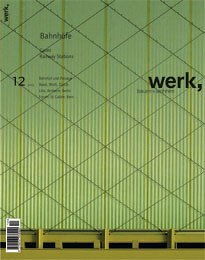Editorial
Railway Stations
Railways stations are portals at the transition between a unified system of railway tracks and a multitude of towns and villages. They are places of farewell and, on the other hand, places of arrival where we leave the non-place of the journey behind. In the past, railway companies used to take this situation into account and by adapt the building typology of their stations to local conditions, not only in terms of their location, but also in their formulation and expression. Whereas the signs and signals of railways stations are part of the system, the actual buildings are parts of the towns and villages, and sometimes even their outposts. This is probably one of the reasons that the railways are such a pronounced part of the Swiss identity, because - rather like the institution of the federal state - they constitute a network linking the different regions and combining a unified structure with local variety in the stations. Seen from this angle, the new standardised RV05 Swiss Federal Railways regional stations and their bold, aggressive appearance are more than just a design issue. Now regarded as an established part of the traffic system, the railways are relinquishing their function as mediator between the place and the system. The stations now play a part similar to that of public transport tram or bus stops in the towns as stops for the transport services of the „metropolis Switzerland“. But although this image is eloquent, it is also slightly erroneous since it disregards the differences and, being basically centralistic, is contrary to the multifaceted nature of Switzerland's cultural identity. Consequently, the new train stations do not strengthen the existing image of the Swiss Federal Railways but are an expression of a drastic and thoroughly questionable change from the old station-identity to brand buildings. Railway stations are public buildings. As such, they claim a special status, and often enough special rights as well, a fact that must be respected today as it has been in the past. The arbitrariness of the use to which of many of the station buildings vacated by the Federal Railways are put is unsatisfactory. Places of arrival are important, if not for the railways, then certainly for the towns and villages. Is it they who should now assume the role of building command and station operator? In this context, the small station of Saanenmöser could prove to be a pioneer: the local tourist association has taken over the ticket counter and, while still carrying out duties for the railways and the post office, is primarily concerned with the organisation of the reception and facilities of passengers passing through the station. As a gateway to the region. The Editors
